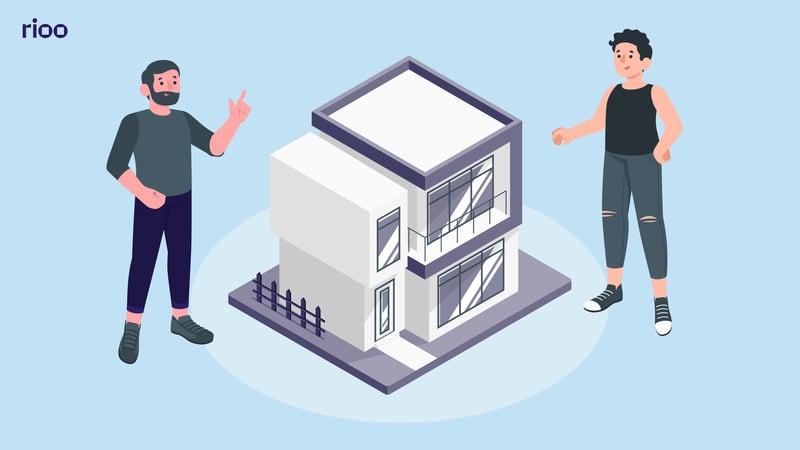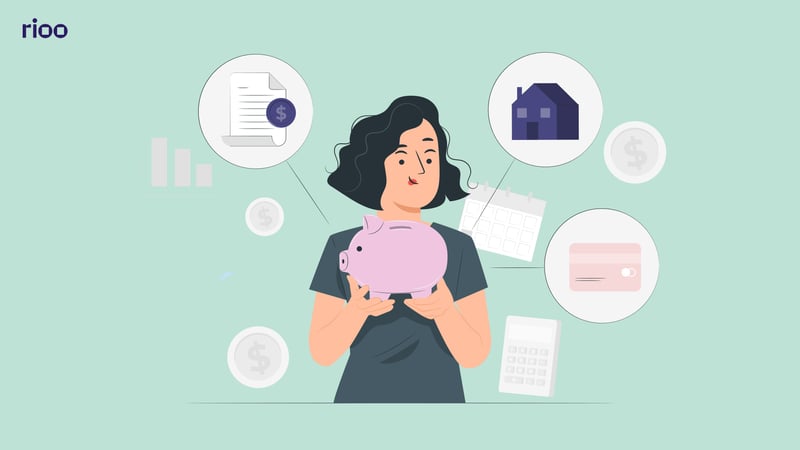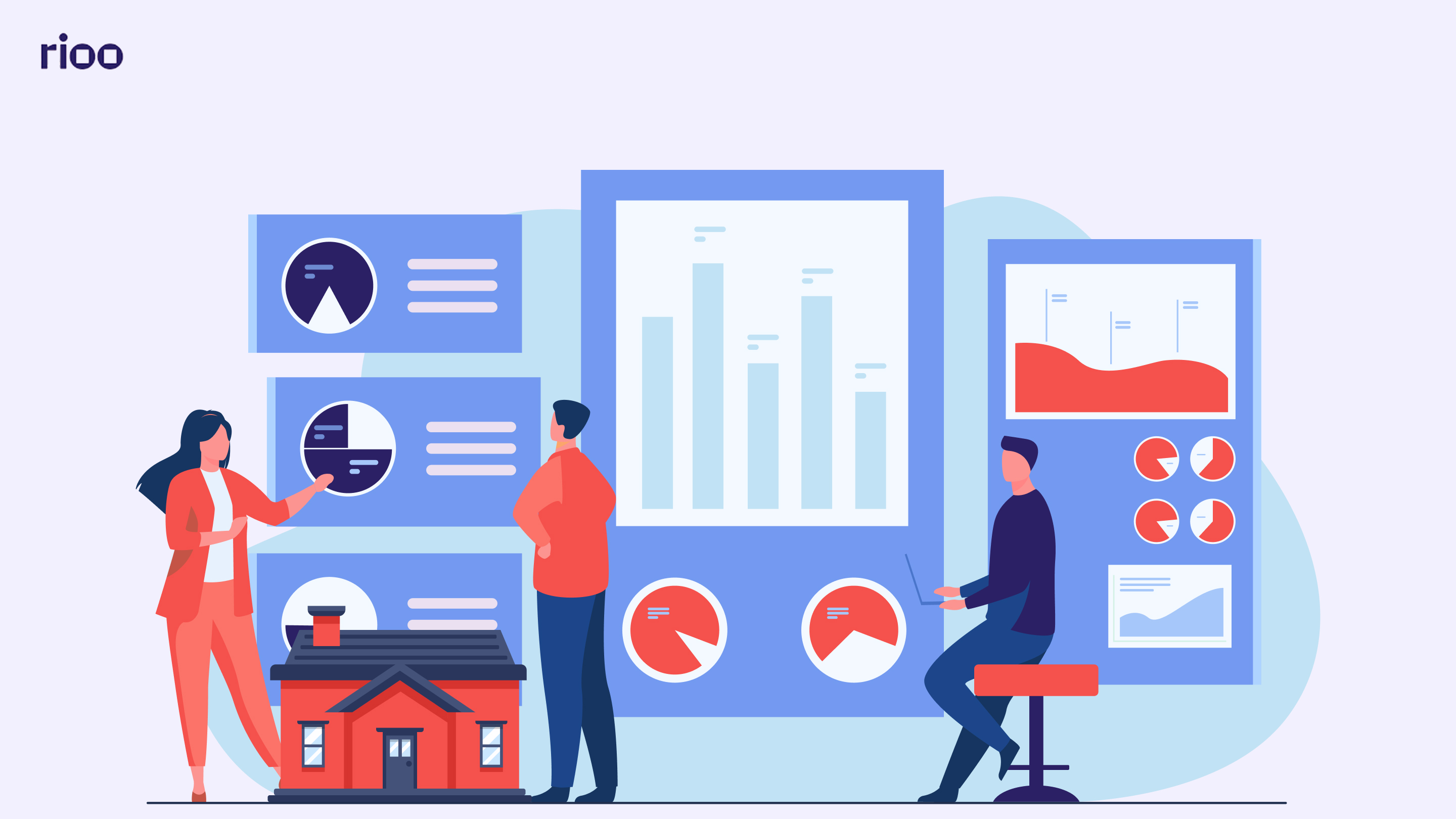The multifamily housing sector is on the rise, with the global market for multifamily housing construction projected to grow from $918.51 billion in 2025 to a staggering $1.35 trillion by 2029, at a 10.2% compound annual growth rate (CAGR).
This growth is fueled by the increasing demand for rental properties, as well as a landlord-friendly environment characterized by stabilizing vacancy rates and moderate rent growth. According to CBRE, vacancy rates are expected to stabilize at 4.9% by the end of 2025, with rent growth projected at 2.6%.
The market’s positive trajectory is supported by a combination of rising absorption rates and the decline in oversupply in key urban markets, as highlighted by the Wall Street Journal.
For property managers and owners in this growing sector, multifamily housing management is more important than ever. This blog will cover the core responsibilities and best practices of multifamily housing management, with insights into the trends shaping the industry in 2025 and beyond. Keep reading!
Key Takeaways
- Multifamily housing management involves overseeing tenant relations, property maintenance, financial management, and legal compliance, all of which are essential for property success.
- Key trends such as sustainability, remote work, and the rise of smart technologies are shaping the industry, and adapting to these will give property managers a competitive benefit.
- Adapting property management software and smart tech can increase operational efficiency, predict maintenance needs, and improve tenant satisfaction.
- Creating a sense of community and offering high-quality amenities not only enhances tenant experience but also reduces turnover and helps maintain high occupancy rates.
What is Multifamily Housing Management?
Multifamily properties are residential buildings that house multiple individual housing units within a single structure or complex. These properties can range in size from small duplexes with just two units to large apartment complexes or condominiums with hundreds of units.
Common types of multifamily properties include:
- Duplexes: Two separate units within a single building, usually one on top of the other or side by side.
- Apartment Complexes: Larger buildings with multiple rental units, often with shared amenities such as parking, laundry facilities, and recreational spaces.
- Condominiums: Similar to apartments but with individually owned units within a shared building.
Managing these types of properties requires overseeing a wide variety of tasks, including leasing, maintenance, tenant relations, and financial management. Unlike single-family rentals, where the property manager deals with one tenant or family, multifamily housing management involves multiple tenants in one property, which brings its own set of unique challenges and responsibilities.
Core Responsibilities of Multifamily Housing Management
Effective multifamily housing management requires a comprehensive approach to keep the property running smoothly and efficiently. The core responsibilities include:
- Tenant Management: Managing relationships with multiple tenants, addressing their concerns, resolving disputes, and ensuring they are satisfied with the property. It also includes tenant acquisition thorough screening processes.
- Property Maintenance: Ensuring the property is well-maintained and in good condition. This includes routine upkeep (landscaping, cleaning common areas) and managing any repair requests. Proactive maintenance helps prevent larger, costly repairs in the future.
- Financial Oversight: Setting competitive yet profitable rental rates, collecting rent on time, and ensuring the property remains financially viable. Property managers also create budgets, handle operating expenses, and track income to maintain a steady cash flow.
- Legal Compliance: Understanding and adhering to housing laws and regulations, such as tenant rights, fair housing laws, and zoning laws. Proper compliance prevents legal issues and protects both the property owner and tenants.
Why Multifamily Housing Management is Complex?
The complexity of multifamily housing management arises from the need to balance tenant satisfaction with operational efficiency. Property managers must juggle competing priorities, including handling tenant issues, maintaining the property, and ensuring financial stability.
Moreover, large-scale multifamily properties often come with diverse tenant needs, regulatory requirements, and higher costs, making effective management critical to the property’s long-term success.
Are you managing multiple properties, or just starting out? RIOO can optimize every aspect of your property management, from tenant communications to financial reporting. No matter the property type, our platform makes management simpler, more efficient, and more profitable. Book your demo now.
Key Trends Shaping Multifamily Housing Management in 2025
The multifamily housing market is experiencing a significant transformation driven by evolving tenant preferences, technological advancements, and regulatory changes. Property managers must stay informed about these trends to remain competitive in 2025.
Here are the key trends that will shape multifamily housing management:
1. Sustainability and Green Initiatives
Sustainability continues to be a top priority for both tenants and property managers. A survey by the National Association of REALTORS® found that 75% of renters expressed a preference for eco-friendly living spaces, with many willing to pay a premium for energy-efficient features like smart thermostats and solar panels.
This demand for green living options is fueling a shift towards more sustainable buildings, which can help reduce operational costs and attract environmentally-conscious tenants.
Moreover, regulatory pressures are increasing. For example, in October 2024, almost every U.S. state, except for two, experienced at least moderate drought conditions. This has prompted a reevaluation of water usage and sustainability practices in multifamily housing, with property managers adopting water-saving technologies and energy-efficient upgrades to comply with new environmental policies.
-
Why it matters: Sustainable practices not only help lower costs but also increase property value and appeal to a growing base of eco-conscious tenants.
2. Rise of Remote Work and Flexible Living Spaces
The rise of remote work has led to nearly a tripling in the demand for work-from-home-friendly apartments. Tenants now prioritize features like high-speed internet, dedicated office spaces, and access to co-working areas.
Additionally, suburban appeal is on the rise. In low-density suburbs and rural areas of large markets, home values and prices have surged by as much as 36%, driven by the flexibility remote work offers in terms of location.
As tenants seek more affordable, spacious living options, property managers must adapt by offering larger units and amenities that support a more relaxed, work-friendly lifestyle.
-
Why it matters: Offering flexible living spaces and ensuring that properties have the necessary infrastructure for remote work will help property managers stay competitive.
3. Technology and Smart Homes
The adoption of smart home technology is revolutionizing multifamily housing management. Features like keyless entry, AI-powered security systems, and smart thermostats are not only enhancing the tenant experience but also improving operational efficiency.
According to McKinsey & Company, real estate companies have seen over a 10% increase in net operating income due to more efficient operating models driven by smart technologies.
-
Why it matters: Implementing smart technologies not only increases property value but also boosts tenant satisfaction and operational efficiency.
4. Urban vs. Suburban Trends
While urban properties remain popular due to their proximity to work and entertainment, suburban multifamily construction is on the rise. Cities like Austin, Phoenix, and Denver are seeing a surge in multifamily development as tenants seek more affordable, spacious living options outside city centers.
This trend is especially evident in areas where suburban living offers a more relaxed lifestyle and access to nature.
Additionally, the demand for larger living spaces and community amenities, such as fitness centers, parks, and pet-friendly areas, is driving the shift to suburban living. As remote work continues to influence tenant preferences, more people are choosing the suburbs for their larger homes and the ability to enjoy a quieter lifestyle.
-
Why it matters: Property managers in both urban and suburban areas must tailor their offerings to meet the changing demands.
5. Sustainability and Regulatory Pressures
The frequency of heatwaves has tripled since the 1960s, and extreme weather events like heavy precipitation have surged in recent years. According to Urban Land, nine of the top 10 years for extreme rainfall have occurred since 1995.
These climate risks are influencing real estate decisions, prompting multifamily housing managers to adopt sustainable practices such as energy-efficient HVAC systems, water conservation measures, and green building certifications.
Furthermore, between July 2024 and June 2025, over 30 U.S. states passed pro-housing bills, reflecting a growing momentum for housing reform and the integration of sustainability into housing policies. Property managers will need to stay updated on these policy reforms and adapt their properties to meet the new requirements.
-
Why it matters: Incorporating sustainable features and staying informed about climate risks and policy reforms will help property managers future-proof their properties.
As the market evolves, leading companies are adapting to these trends. Let’s examine the top players in multifamily housing management and the strategies driving their success.
Also Read: Top 10 Property Management Marketing Strategies to Boost Your Business
Top 10 Multifamily Property Management Companies of 2025
The top 10 multifamily property management companies of 2025 are shaping the industry with large-scale portfolios, impressive growth, and consistently high occupancy rates. These leading firms are not just growing in scale but are also adopting digital transformation to optimize day-to-day operations, such as lease management, predictive maintenance, and financial tracking.
For property managers looking to emulate the success of these industry leaders, platforms like RIOO can provide essential tools for streamlining operations, automating maintenance, and enhancing tenant engagement.
|
Company |
Units Managed |
Communities |
Growth (2023-2024) |
Occupancy Rate |
|
Greystar |
980,368 |
3,689 |
+17.5% |
93% |
|
Asset Living |
288,665 |
1,655 |
+42.4% |
93.5% |
|
RPM Living |
218,661 |
920 |
+47.1% |
93% |
|
Willow Bridge Property Co. (fka Lincoln Property Co.) |
220,676 |
864 |
+19.5% |
93.5% |
|
Cushman & Wakefield |
157,485 |
814 |
- |
93.2% |
|
Avenue5 Residential |
142,841 |
721 |
+17.2% |
93.2% |
|
Bozzuto |
121,232 |
386 |
+19.5% |
94% |
|
WinnResidential |
116,337 |
760 |
+6.7% |
95.3% |
|
BH Management Services |
107,000 |
377 |
- |
93.6% |
|
Morgan Properties |
97,384 |
352 |
+4.8% |
94% |
While these companies are achieving success, multifamily housing management is not without its challenges. Let’s explore the common obstacles property managers face and how they impact day-to-day operations.
Read More: Financial Oversight Made Simple: Managing Budgets and Expenses with a Community Manager Portal
Challenges in Multifamily Housing Management
Multifamily housing management comes with a unique set of challenges. While property managers strive to provide quality service to tenants and maintain high occupancy rates, various hurdles can impact day-to-day operations.
Here are some of the most significant challenges property managers face in the multifamily housing sector.
1. Managing Tenant Turnover
Unlike single-family rentals, where tenants tend to stay longer, multifamily properties often face higher turnover rates. Frequent turnover means property managers must constantly market vacant units, conduct screenings, and manage move-ins and move-outs, which can be time-consuming and costly.
2. Legal and Regulatory Compliance
Multifamily property managers are required to comply with a wide range of local, state, and federal laws. These include tenant rights, fair housing regulations, building codes, and tax laws. Non-compliance with these laws can lead to hefty fines, legal disputes, and reputational damage.
3. Managing Operational Costs and Rising Expenses
The rising cost of utilities, maintenance, and labor has increased the financial burden on property managers. Multifamily buildings require regular upkeep, from landscaping and cleaning common areas to maintaining HVAC systems and appliances. Additionally, fluctuating energy prices and inflation can significantly affect operating costs.
4. Security and Safety Concerns
Ensuring the safety and security of tenants is a crucial responsibility for multifamily property managers. Managing access control systems, monitoring surveillance cameras, and ensuring the building’s infrastructure is safe from hazards such as fires and structural damage are ongoing tasks. With larger complexes, this becomes even more complex.
5. Tenant Expectations and Satisfaction
Modern tenants have high expectations for convenience, technology, and amenities. Meeting these expectations while maintaining operational efficiency can be a challenge for property managers.
6. Technological Integration
Although technology can be an asset, integrating property management software, smart building systems, and AI-powered tools into daily operations can be challenging for some managers. The investment in these technologies, along with training staff to use them efficiently, requires significant time and resources.
Adopting the right technology can streamline operations, improve tenant experiences, and reduce administrative costs. However, the challenge lies in selecting the appropriate systems, integrating them effectively, and ensuring ongoing staff training and support.
Tackle property management challenges head-on with RIOO. From tenant turnover to compliance, RIOO’s all-in-one platform supports 150,000+ homes and 400,000+ tenants. Try RIOO now and streamline your operations.
Despite these challenges, there are effective strategies to overcome them. Here’s a look at the best practices for managing multifamily properties successfully.
Read more: How Property Management Companies Can Streamline Maintenance with SmartTools
Best Practices for Successful Multifamily Housing Management
Effective multifamily housing management requires a comprehensive approach to operations, tenant relations, and financial stability. The following best practices address key areas such as financial management, tenant satisfaction, technology adoption, security, and legal compliance, all crucial to the long-term success of multifamily properties.
1. Efficient Financial and Budget Management
Strong financial oversight is the foundation of any successful multifamily property management strategy. It ensures profitability, reduces costs, and helps maintain financial stability.
- Set Competitive Rent Prices: Regularly assess local rental markets and adjust prices accordingly to stay competitive while ensuring profitability.
- Streamline Rent Collection: Use online payment systems to make rent collection easy for tenants and track payments efficiently. Enforce late fees to maintain cash flow.
- Monitor Expenses: Continuously track operating costs, from maintenance to utilities, and look for areas to save, such as negotiating contracts with service providers or implementing energy-saving technologies.
- Financial Transparency: Use property management software to generate real-time financial reports. Provide property owners and investors with regular updates on income, expenses, and overall property performance.
Simplify your financial tracking with RIOO’s automated rent collection and real-time insights. RIOO helps manage $150M+ in monthly rent across 1,500+ communities, improving cash flow and financial oversight. Get started today.
2. Proactive Maintenance and Upkeep
Well-maintained properties retain their value, attract high-quality tenants, and ensure tenant satisfaction. Proactive maintenance is key to minimizing operational disruptions.
- Routine Inspections and Preventive Maintenance: Schedule regular inspections to spot potential issues early. Implement predictive maintenance using technology to anticipate equipment failures before they occur.
- Quick Response to Maintenance Requests: Use property management software to streamline the submission and tracking of maintenance requests. Respond promptly to avoid tenant dissatisfaction.
- Keep Common Areas Clean and Functional: Ensure that shared spaces are regularly cleaned and maintained. This enhances tenant comfort and helps improve the property's overall appeal.
3. Utilize Technology to Enhance Operations
Technology is transforming how multifamily properties are managed. Adopting the right tech tools can streamline operations, enhance security, and improve tenant experiences.
- Use Property Management Software: Automate tasks like rent collection, lease renewals, and maintenance management to save time and reduce errors. These platforms also provide real-time data on tenant satisfaction and property performance.
- Implement Smart Technologies: Invest in smart thermostats, keyless entry systems, and AI-powered security features. These technologies increase efficiency and appeal to tech-savvy tenants.
- Data-Driven Decision Making: Use data analytics to optimize rent pricing, monitor market trends, and understand tenant behavior. This helps make informed decisions that improve both tenant retention and profitability.
Suggested Read: Beyond Rent Collection: Unexpected Ways Property Management Software Saves Time
4. Building a Positive Tenant Experience
Happy tenants are long-term tenants. By building a positive living environment and creating strong tenant relationships, property managers can reduce turnover and maintain high occupancy rates.
- Create a Sense of Community: Organize social events, offer communal spaces, and encourage interaction among tenants. A vibrant community leads to higher tenant satisfaction and retention.
- Provide High-Quality Amenities: Offer in-demand amenities such as fitness centers, pet-friendly spaces, and co-working areas. Keep these amenities in good condition and make sure they meet tenant expectations.
- Offer Personalized Services: Tailor services to individual tenant needs, such as offering flexible lease terms or special accommodations. Personalized experiences lead to higher tenant satisfaction and loyalty.
5. Ensuring Legal Compliance and Risk Management
Legal compliance and risk management are crucial to avoiding costly lawsuits, penalties, and reputational damage. Staying ahead of legal requirements and mitigating risks can protect both the property and its tenants.
- Understand Housing Laws: Stay informed about local, state, and federal laws, including fair housing regulations and tenant rights. Regularly train staff to ensure compliance.
- Implement Strong Lease Agreements: Ensure that all leases are clear, legally sound, and comprehensive. Include details on rent payment terms, maintenance responsibilities, and tenant rights to avoid misunderstandings.
- Mitigate Legal Risks: Maintain thorough documentation of tenant interactions, maintenance requests, and financial transactions. This can be critical if disputes arise or if legal action is needed.
- Risk Management and Insurance: Invest in adequate insurance coverage to protect against property damage, liability claims, and other risks. Conduct regular safety inspections and address hazards promptly.
6. Enhancing Tenant Security and Safety
Tenant safety is a top priority for property managers. Implementing robust security measures not only protects tenants but also builds trust and enhances the property's appeal.
- Invest in Smart Security Systems: Use surveillance cameras, access control systems, and alarm systems to enhance security. Smart features like keyless entry can provide added convenience and peace of mind.
- Ensure Building Safety: Regularly inspect the property for potential hazards, such as faulty electrical systems or fire risks. Take action immediately to address any safety concerns.
- Build a Safe Environment: Encourage tenants to report security issues and work with local law enforcement to ensure the property remains a safe and secure place to live.
Suggested Read: How Streamlined Financial Tracking Cuts Down Operational Waste in Property Management
Wrapping Up
Multifamily housing management today demands more than rent collection and maintenance. Property managers must balance finances, compliance, and tenant expectations while adapting to sustainability, remote work, and smart technology. The role has shifted from caretaker to strategist, requiring proactive adoption of green practices, data-driven decisions, and strong tenant communities. Success depends on preparation and adaptability, understanding trends, addressing challenges, and applying best practices to protect profitability and enhance tenant experience. With RIOO, you gain the tools to streamline operations, anticipate needs, and manage even the most complex portfolios with precision. See how RIOO can transform your property management—Book Your Demo Now!.
Also Read: The Hidden Costs of Skipping the Details in Property Setup
FAQs
1. How do property managers handle tenant screening in multifamily properties?
Property managers conduct thorough background checks, including credit history, criminal records, and rental history, to ensure tenants are reliable and a good fit for the property. This helps reduce the risk of late payments and ensures a positive living environment for everyone.
2. What are the benefits of using technology in multifamily housing management?
Technology streamlines operations by automating tasks such as rent collection, maintenance requests, and tenant communication. Tools like RIOO also help manage property data, predict maintenance needs, and improve tenant satisfaction, making it easier to manage large multifamily properties efficiently.
3. How can property managers reduce tenant turnover?
Property managers can reduce turnover by providing high-quality amenities, maintaining the property well, and creating a strong sense of community. Offering flexible lease terms, personalized services, and regular communication also helps keep tenants satisfied and less likely to move.
4. Why is financial management important in multifamily housing?
Financial management is crucial for maintaining a profitable property. It involves setting competitive rent prices, managing expenses, collecting rent on time, and ensuring cash flow. Effective financial planning ensures the property remains viable and provides consistent returns for owners.
















